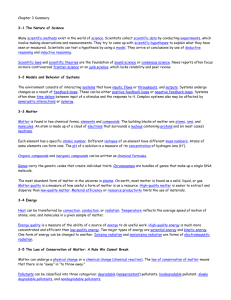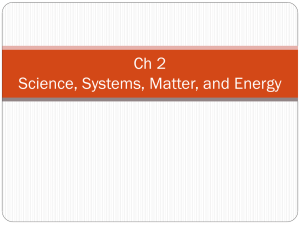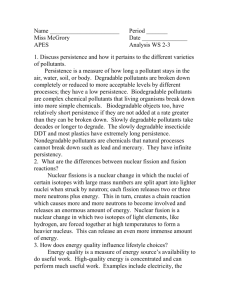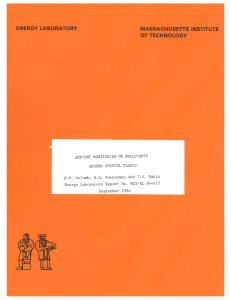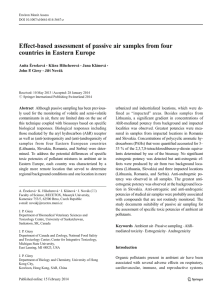Apes-ch-2
advertisement
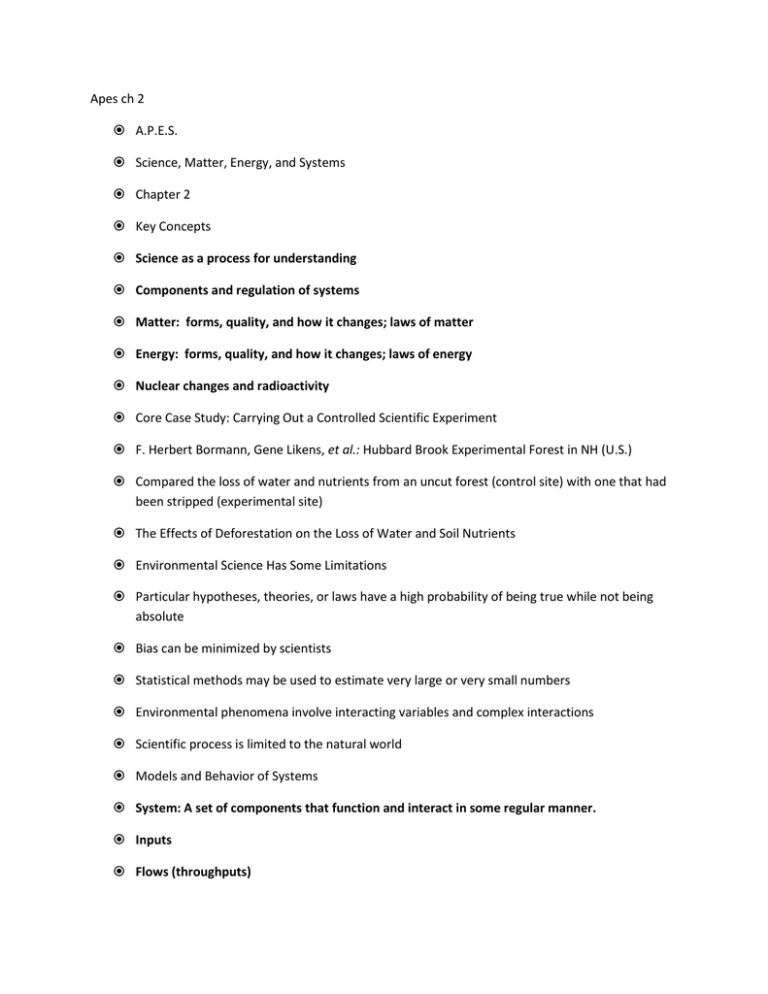
Apes ch 2 A.P.E.S. Science, Matter, Energy, and Systems Chapter 2 Key Concepts Science as a process for understanding Components and regulation of systems Matter: forms, quality, and how it changes; laws of matter Energy: forms, quality, and how it changes; laws of energy Nuclear changes and radioactivity Core Case Study: Carrying Out a Controlled Scientific Experiment F. Herbert Bormann, Gene Likens, et al.: Hubbard Brook Experimental Forest in NH (U.S.) Compared the loss of water and nutrients from an uncut forest (control site) with one that had been stripped (experimental site) The Effects of Deforestation on the Loss of Water and Soil Nutrients Environmental Science Has Some Limitations Particular hypotheses, theories, or laws have a high probability of being true while not being absolute Bias can be minimized by scientists Statistical methods may be used to estimate very large or very small numbers Environmental phenomena involve interacting variables and complex interactions Scientific process is limited to the natural world Models and Behavior of Systems System: A set of components that function and interact in some regular manner. Inputs Flows (throughputs) Stores (storage areas) Outputs System Regulation Feedback loop: When an output of matter, energy, or information is feed back into the system as an input and changes the system Positive Feedback: Causes the system to change in the same direction Negative Feedback: Causes a system to change in the opposite direction Time Delay: Time between input and response Synergy: Two or more processes interact to produce a greater effect than if left separate Matter: Forms, Structure, and Quality Elements Compounds Atoms Ions Molecules Atoms Subatomic Particles Protons Neutrons Electrons Atomic Characteristics Atomic number Atomic mass Ions Isotopes Ions Important to the Study of Environmental Science Loss of NO3− from a Deforested Watershed Science Compounds Important to the Study of Environmental pH Measures acidity or alkalinity of water samples Scale 0 – 14 Acids: 0 – 6.9 Neutral 7.0 Alkaline (Basic) 7.1 – 14 Chemical Bonds Chemical formulas C6H12O6 + 6 O2 6 Co2 + 6 H2O Ionic bonds NaCl Covalent bonds H2O Organic Compounds Organic vs. inorganic compounds Hydrocarbons Chlorinated hydrocarbons Simple carbohydrates Complex carbohydrates Proteins Nucleic acids The Four States of Matter Solid Liquid Gas Plasma Matter Quality and Material Efficiency High-quality matter Low-quality matter Material efficiency (resource productivity) Energy Definition: Capacity to do “work” and transfer heat Types: Kinetic Potential Radiation: Energy & Wavelength Electromagnetic Spectrum Transfer of Heat Energy Changes in Matter Physical Chemical The Law of Conservation of Matter Matter is not destroyed Matter only changes form There is no “throw away” Matter and Pollution Chemical nature of pollutants Concentration Persistence Degradable (non-persistent) pollutants Biodegradable pollutants Slowly degradable (persistent) pollutants Non-degradable pollutants Nuclear Changes Natural radioactive decay Radioactive isotopes (radioisotopes) Gamma rays Alpha particles Beta particles Half life (See Table 3-2 p. 49) Ionizing radiation Laws Governing Energy Changes First Law of Thermodynamics (Energy) Energy is neither created nor destroyed Energy only changes form You can’t get something for nothing ENERGY IN = ENERGY OUT Laws Governing Energy Changes Second Law of Thermodynamics In every transformation, some energy is converted to heat You cannot break even in terms of energy quality Connections: Matter and Energy Laws and Environmental Problems High-throughput (waste) economy Matter-recycling economy Low-throughput economy Environmental Solutions: Low-Throughput Economy Learning from Nature

